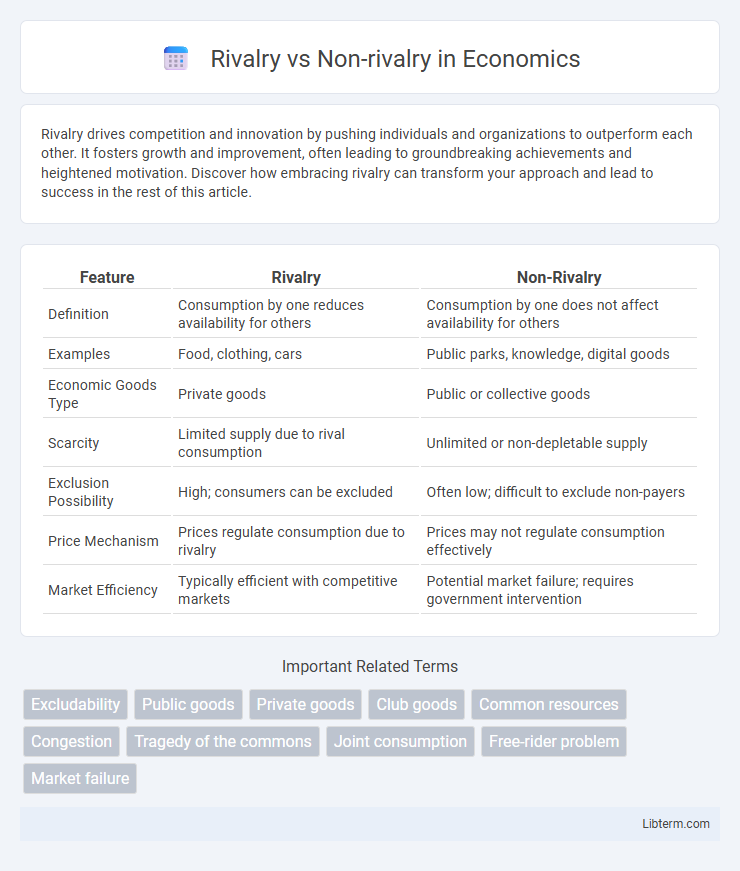Rivalry drives competition and innovation by pushing individuals and organizations to outperform each other. It fosters growth and improvement, often leading to groundbreaking achievements and heightened motivation. Discover how embracing rivalry can transform your approach and lead to success in the rest of this article.
Table of Comparison
| Feature | Rivalry | Non-Rivalry |
|---|---|---|
| Definition | Consumption by one reduces availability for others | Consumption by one does not affect availability for others |
| Examples | Food, clothing, cars | Public parks, knowledge, digital goods |
| Economic Goods Type | Private goods | Public or collective goods |
| Scarcity | Limited supply due to rival consumption | Unlimited or non-depletable supply |
| Exclusion Possibility | High; consumers can be excluded | Often low; difficult to exclude non-payers |
| Price Mechanism | Prices regulate consumption due to rivalry | Prices may not regulate consumption effectively |
| Market Efficiency | Typically efficient with competitive markets | Potential market failure; requires government intervention |
Understanding Rivalry vs Non-Rivalry
Rivalry in economics refers to the consumption of a good or service by one individual that reduces its availability for others, such as food or clothing, whereas non-rivalry applies to goods that can be consumed simultaneously by multiple people without depletion, like digital downloads or public broadcasts. Understanding rivalry and non-rivalry is essential for distinguishing between private goods, which are both rival and excludable, and public goods, which are non-rival and non-excludable, impacting resource allocation and market efficiency. This distinction influences policy decisions on taxing, subsidizing, or regulating goods to address issues like congestion, free-riding, and optimal provision in the economy.
Defining Rivalrous and Non-Rivalrous Goods
Rivalrous goods are those whose consumption by one individual directly reduces their availability for others, such as food or clothing, creating competition for limited resources. Non-rivalrous goods, like public parks or digital downloads, can be consumed simultaneously by many without diminishing the quantity or quality available to others. Understanding this distinction is crucial for economic allocation and policy-making, influencing how goods are priced, distributed, and regulated.
Key Characteristics of Rivalry
Rivalry in economics refers to a good or resource that can be consumed by only one person at a time, meaning its consumption by one individual reduces availability for others. Key characteristics of rivalry include exclusivity in consumption, where usage limits or diminishes access for others, and the inability to share the resource simultaneously without depletion. Examples of rival goods are food, clothing, and cars, contrasting with non-rivalrous goods like public broadcasts or digital products that can be consumed simultaneously by multiple users without reducing availability.
Examples of Rivalrous Goods
Rivalrous goods include tangible items such as food, clothing, and cars, where consumption by one individual reduces availability for others. For example, if one person eats an apple, that specific apple cannot be consumed by anyone else. Other examples include tickets to a concert or a seat in a stadium, as their use by one person excludes use by another.
Non-Rivalrous Goods Explained
Non-rivalrous goods allow multiple individuals to consume the same product simultaneously without diminishing its availability, such as digital streaming services or public broadcasts. These goods often have zero marginal cost for additional users, enabling widespread accessibility without depletion. Understanding non-rivalrous goods is crucial for developing effective public policies and economic models, especially in digital economies and shared resources.
Implications for Resource Allocation
Rivalry in resource consumption means one person's use diminishes availability for others, necessitating careful allocation to prevent depletion and ensure equitable access. Non-rivalrous resources, like digital goods or public broadcasts, allow simultaneous use without reduction in availability, enabling broader distribution without competition constraints. This distinction influences economic policies: rivalrous resources often require price mechanisms or quotas, while non-rivalrous resources benefit from open access and investment in capacity expansion.
Rivalry in Digital vs Physical Products
Rivalry in digital products is minimal because digital goods like software, ebooks, or streaming services can be consumed simultaneously by multiple users without depletion, whereas physical products such as clothing or food are inherently rivalrous due to limited availability and consumption by one user preventing use by another. This fundamental difference impacts market dynamics, with digital products benefiting from scalability and reduced marginal costs, contrasting with the inventory and exclusivity constraints governing physical goods. As a result, businesses must tailor strategies to address scarcity in physical markets while leveraging the non-rivalrous nature of digital goods for broader distribution and customer access.
Economic Impact of Non-Rivalry
Non-rivalrous goods, such as digital software and public broadcasting, allow multiple individuals to consume the same resource simultaneously without depletion, leading to increased economic efficiency and scalability. This characteristic significantly reduces marginal costs and promotes widespread access, fueling innovation and market expansion in sectors like information technology and creative industries. The economic impact of non-rivalry enhances social welfare by enabling broader consumption and reducing exclusion costs, thus fostering inclusive growth.
Public Goods and Non-Rivalry
Non-rivalry in public goods means that one individual's consumption does not reduce availability for others, exemplified by services like national defense and street lighting. Public goods are characterized by their non-rivalrous nature, ensuring that multiple people can benefit simultaneously without depletion of the resource. This contrasts with rivalrous goods, where consumption by one person diminishes the quantity available for others.
Real-World Applications and Case Studies
Rivalry and non-rivalry in economics describe how resource consumption affects availability; rival goods like food or clothing diminish with use, while non-rival goods such as digital media or public broadcasting can be consumed simultaneously without depletion. Real-world applications include spectrum allocation in telecommunications, where non-rivalrous wireless frequencies enable multiple users, contrasted with rivalrous goods like limited parking spaces in urban planning. Case studies in renewable energy demonstrate non-rivalry in solar power usage, allowing shared access without reduced output, whereas fossil fuel consumption exemplifies rivalry due to finite resource depletion.
Rivalry Infographic

 libterm.com
libterm.com